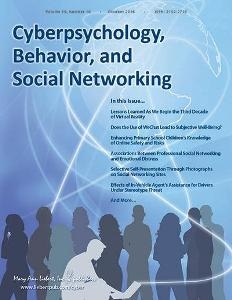Oct 20 2016
Strategic messaging that precedes human-robot interaction can help build the trust needed for effective human-robot communication and positive interaction outcomes, according to a study published in Cyberpsychology, Behavior, and Social Networking, a peer-reviewed journal from Mary Ann Liebert, Inc., publishers. The article is available free on the Cyberpsychology, Behavior, and Social Networking/a> website until November 19, 2016.
 Cyberpsychology, Behavior, and Social Networking (http://www.liebertpub.com/cyber) is an authoritative peer-reviewed journal published monthly online with Open Access options and in print that explores the psychological and social issues surrounding the Internet and interactive technologies. Complete tables of contents and a sample issue may be viewed on the Cyberpsychology, Behavior, and Social Networking (http://www.liebertpub.com/cyber) website. ©Mary Ann Liebert, Inc., publishers
Cyberpsychology, Behavior, and Social Networking (http://www.liebertpub.com/cyber) is an authoritative peer-reviewed journal published monthly online with Open Access options and in print that explores the psychological and social issues surrounding the Internet and interactive technologies. Complete tables of contents and a sample issue may be viewed on the Cyberpsychology, Behavior, and Social Networking (http://www.liebertpub.com/cyber) website. ©Mary Ann Liebert, Inc., publishers
The article entitled "Advancing the Strategic Messages Affecting Robot Trust Effect: The Dynamic of User- and Robot-Generated Content on Human-Robot Trust and Interaction Outcomes" examines the impact of Strategic Messages Affecting Robot Trust (SMART). The researchers conducted two experiments in which they studied the effects of either user-generated information or robot-generated content delivered in the pre-interaction stage on human-robot trust and interaction outcomes.
"As human robot interactions become more prevalent in both our personal and professional lives, it becomes increasingly more important that we understand how to work together most effectively," says Editor-in-Chief Brenda K. Wiederhold, PhD, MBA, BCB, BCN, Interactive Media Institute, San Diego, California and Virtual Reality Medical Institute, Brussels, Belgium. "Drawing on lessons learned from previous animal-human interaction training prior to our engagement may serve to create improved trust and communications."